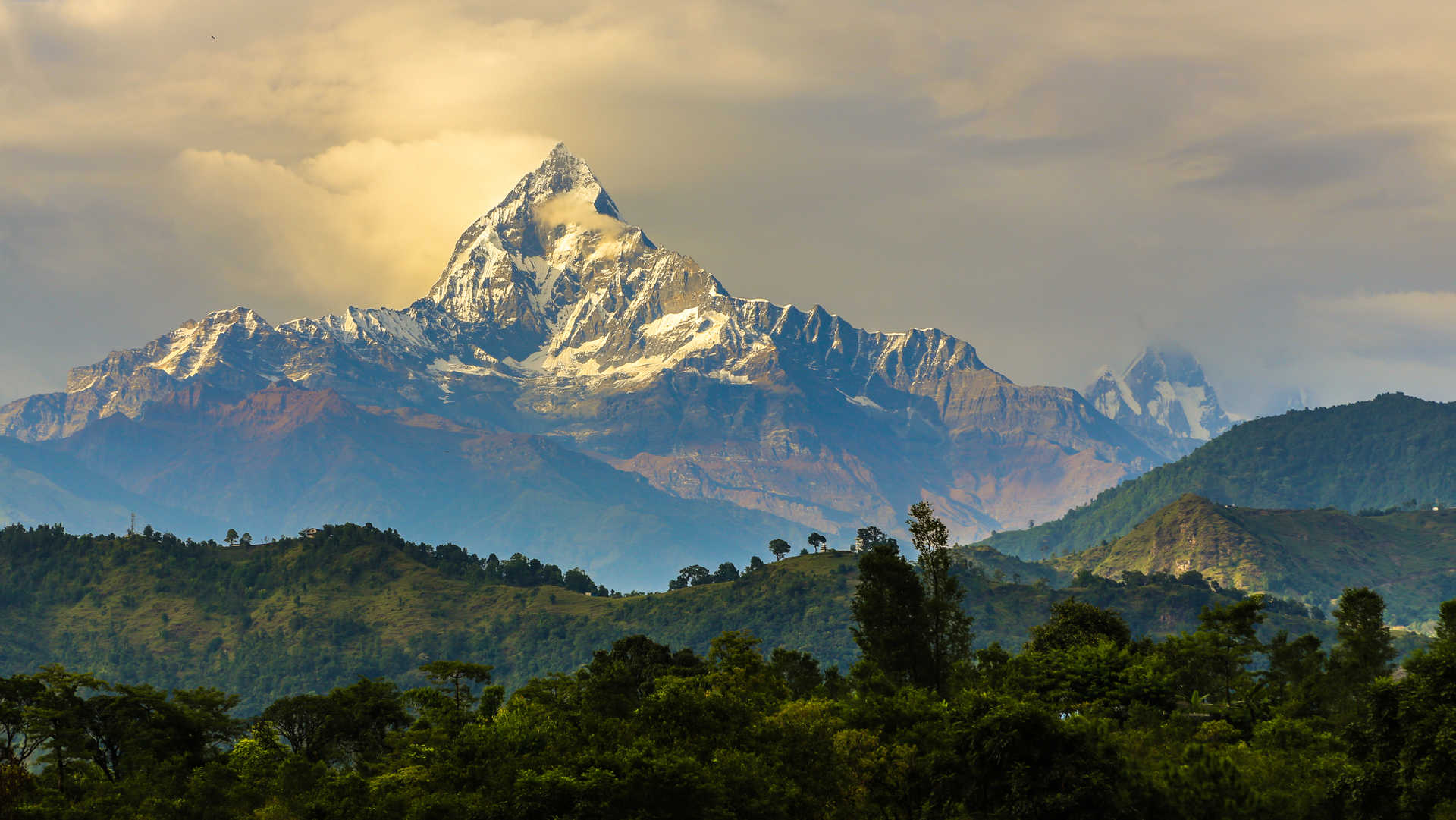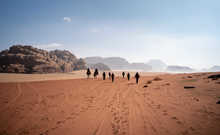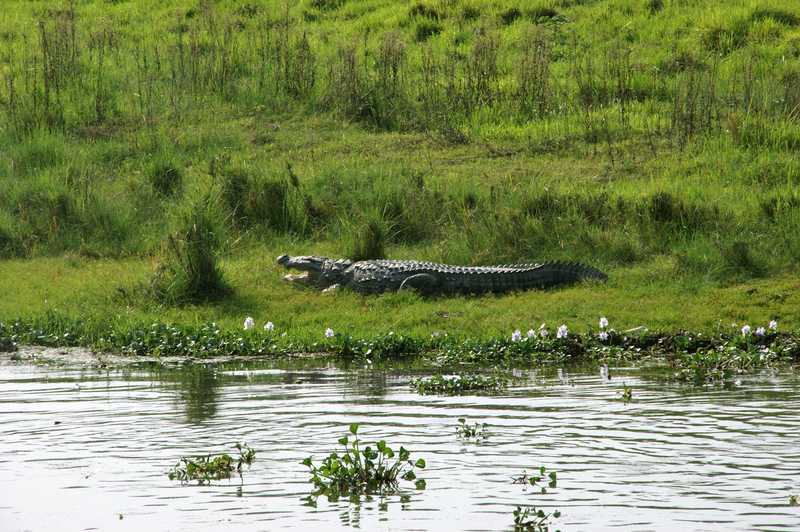The Annapurna Sanctuary
- Kandoo Trekking

Contact
our UK team

All trekkers need to organise their own flights to Kathmandu International Airport (KTM). From Kathmandu Airport we will arrange a private transfer to your hotel. That night you will meet your local Kandoo representative and have a full pre-trek briefing.
We will take a morning flight to Pokhara, with magnificent views of Dhaulagiri, Manaslu, Machhapuchhre, the five peaks of Annapurna and many others. We will then drive for one hour to Nayapul where we start our trek. We follow the south bank of the river, passing through sub-tropical valley forests and crossing the Modi Khola on a high suspension bridge. We continue to ascend on this trail until we reach the village of Tikhedhunga where we will spend the night.
We leave the small village of Thikedhungga, crossing the small suspension bridge across the deep gorge to start your steep ascent up to Ulleri. Fortunately there are steps all the way which makes this tough climb slightly easier. After Ulleri, the trail continues winding its way through the rhododendron forests, passing beautiful waterfalls and we climb up, and down a little, enjoying the views of Machhapuchhre (Fish Tail) peeking out high above the lush green hillsides. Eventually we reach the village of Ghorepani and are rewarded with breath-taking views of Dhaulagiri and the Annapurna range.
We will set off in the dark this morning to ascend Poon Hill, renowned as one of the best view points in Nepal. The trail climbing to Poon Hill's viewpoint is steep, but it is well rewarded with spectacular views of Machhapuchhre, Dhaulagiri, Nilgiri, and the Annapurnas as the sun rises. We then begin our descent down to Tadapani through rhododendron forests with beautiful views of the high mountains and lush green valleys.
We will trek down through the village of Chuile and then descend to Lower Chomrong, before climbing the thousand stony steps taking us to Upper Chomrong.
The trail from Chomrong descends to cross the Chomrong Khola, before ascending out of the valley through rhododendron forests and bamboo thickets. In a clearing in the forest is the village of Bamboo.
Today we start our trek to Machhapuchhre Base Camp (MBC). This is quite a strenuous hike but well worth the effort as the spectacular view of Machhapuchchhre unfolds before you. Passing between the heights of Hiunchuli and Machhapuchhre, we reach Machhapuchhre Base Camp, where we spend the night.
On the way to Annapurna Base Camp from Machhapuchhre Base Camp, the vegetation disappears and we will be trekking amongst glacial moraine. Our first view will be of Annapurna's near vertical south face towering above you. Annapurna Base Camp boasts one of the most awe inspiring 360° views in the Himalaya. We will literally be surrounded by the peaks such as Machhapuchhre, Annapurna South, Annapurna IV and Hiunchuli
We then descend from Annapurna Base Camp to Himalaya retracing our steps through Machhapuchhre Base Camp. Heading back down to the valley is much easier than climbing up! We will see the waterfalls that drop down from a high point to the rocks below.
We will trek down through the villages of Bamboo and Sinuwa to Chomrong.
Today is our last day on the trail as we make our way down to Nayapul and say goodbye to the Annapurna Conservation Park. We will then transfer in a private vehicle (approx. 1½ hours) to your hotel by the lake in Pokhara. To celebrate our final night, we have dinner altogether this evening as a full team, it is customary for guests to buy dinner for the porters and guides on this night as a thank you for the support they have given you throughout the trek. There will also be an opportunity for you to hand out your tips for the support team during this meal.
We take a morning flight from Pokhara to Kathmandu. You have the afternoon free to explore the capital city.
We will collect you from your hotel and transfer you to Kathmandu Airport for your departing flight.
One word of advice, place your meal order as soon as you can upon arriving at the lodge as it is strictly ‘first ordered, first served’, and the best lodges are quite busy at meal times.
Your
full day by day itinerary shows what is included in terms of hotel
accommodation and meal basis. All of our pre- and post-trek nights are in comfortable 4* hotel accommodation based in the Thamel District of Kathmandu.
We insist on using a high standard of
vehicle and driver for all of our transfers. In Nepal it is not a legal
requirement to have seatbelts fitted in the back of vehicles, and while we try
to use vehicles that do have rear seatbelts fitted, this cannot always be
guaranteed. If you are unhappy about any aspect of the vehicle or the standard
of driving, please speak to the driver or our local office immediately.
The
internal flights operate a strict maximum limit of 10kg for your main equipment
bag and 5kg for your day sack. Your bag will be weighed before you leave the
hotel to start the trek and if it is overweight you will have to leave items
behind. Your baggage will also be weighed by the airport staff so it is
important that you do not exceed these limits. You will be given 2 litres of
water on arrival in Pokhara to fill your bottles for your first day’s trekking,
so you do not need to carry water from Kathmandu.
Duffel bags
You will be provided with a large duffel bag at the pre-trek briefing that will be yours to use for the duration of your trek. Your equipment will then need to be transferred into this bag. If you are travelling with a duffel bag then it is up to you which bag you choose to use for the trek, if you are travelling with a suitcase then this will need to be left at the pre-trek hotel and collected upon your return as our porters need the bags they carry to be flexible.
The
porters can carry up to 15kg in the main equipment bag, so there is scope for
your bag to be slightly heavier while you are on the trek. You can move items
from your daysack to your main bag when you reach Pokhara. All items must be
packed in your main bag. They should not be attached to the outside, as we are
not responsible if items fall off when the bags are being carried on the trek.
We recommend that you take local currency on the actual trek
with you, as the teahouses prefer local currency. You will also get a more
favourable exchange rate in Kathmandu than in the mountains. If you are relying
on a credit or debit card for emergency funds, make sure you tell your card
issuer that you will be using it abroad, or you may find that it won't work
when you really need it.
In Kathmandu a meal for two at a mid range restaurant will
cost ~$20. A taxi will generally start on a base rate of $0.45 and then charge
$0.4 for every km. Or you can ride the bus which will be around $0.15 for a 5km
journey. Souvenirs in Kathmandu are generally on the cheaper side too.
Whilst on the trek, we recommend that you budget £30 - £35
($40 to $45) per day for meals and drinks.
We realise that tipping may not be a common practice in all
countries but for Nepal it is a standard practice that all operators
support. The decision on how much to tip should be determined by how well the
team served you while you were on the trek. Tips are always discretionary and
if you are not happy with the service you have received you do not have to pay
tips. Tips can be made in US dollars or Nepali Rupees. It is very important
that US bills be new (less than 10 years old), crisp and untorn.
We are members of the Trekking Agencies Association of Nepal
and the Nepal Mountaineering Association, and follow their guidelines when
recommending tip levels for guides and porters. We would suggest you budget
$175 per trekker for your tip contribution on this route. The group tip can be
given to your porters and guides during your celebratory meal in Pokhara on the
final night of your trek. You will then say goodbye to your porters the
following morning.
Duffel bags
You will be provided with a large duffel bag at the pre-trek briefing that will be yours to use for the duration of your trek. Your equipment will then need to be transferred into this bag. If you are travelling with a duffel bag then it is up to you which bag you choose to use for the trek, if you are travelling with a suitcase then this will need to be left at the pre-trek hotel and collected upon your return as our porters need the bags they carry to be flexible.
We
do not have other gear available for rental but there are many places
offering gear for rental in Kathmandu and we can recommend a number of places
for you. The quality of rental gear is very variable and it is your
responsibility to check carefully the condition of any item you rent. We
accept no responsibility for the quality of equipment hired. An indication of
the likely rental costs is below.
Most
of the rental shops close around 8pm, so if you are arriving on a late flight
the day before the trek starts there will not be an opportunity for you to
visit a rental store. If you are planning on renting equipment, you need to
make sure you have allowed sufficient time at the beginning of your trip.
All
rental equipment is included in your overall trekking bag weight, so make
sure you have allowed for this when packing your bag at home. A sleeping bag
will weigh around 2kg.
UPPER
BODY
LEGS
OTHER ACCESSORIES
| From | To | Price | Availability | Book | Enquire |
|---|---|---|---|---|---|
| 16/02/2026 | 27/02/2026 | £1,379 $1,799 |
Available
|
Book now | Enquire now |
| 16/03/2026 | 27/03/2026 | £1,429 $1,849 |
Available
|
Book now | Enquire now |
| 30/03/2026 | 10/04/2026 | £1,429 $1,849 |
Available
|
Book now | Enquire now |
| 06/04/2026 | 17/04/2026 | £1,429 $1,849 |
Available
|
Book now | Enquire now |
| 27/04/2026 | 08/05/2026 | £1,429 $1,849 |
Available
|
Book now | Enquire now |
| 11/05/2026 | 22/05/2026 | £1,379 $1,799 |
Available
|
Book now | Enquire now |
| 18/05/2026 | 29/05/2026 | £1,379 $1,799 |
Available
|
Book now | Enquire now |
| 25/05/2026 | 05/06/2026 | £1,379 $1,799 |
Available
|
Book now | Enquire now |
| 31/08/2026 | 11/09/2026 | £1,379 $1,799 |
Available
|
Book now | Enquire now |
| 13/09/2026 | 24/09/2026 | £1,379 $1,799 |
Available
|
Book now | Enquire now |
| 21/09/2026 | 02/10/2026 | £1,379 $1,799 |
Guaranteed
|
Book now | Enquire now |
| 12/10/2026 | 23/10/2026 | £1,429 $1,849 |
Available
|
Book now | Enquire now |
| 26/10/2026 | 06/11/2026 | £1,429 $1,849 |
Available
|
Book now | Enquire now |
| 02/11/2026 | 13/11/2026 | £1,429 $1,849 |
Guaranteed
|
Book now | Enquire now |
| 16/11/2026 | 27/11/2026 | £1,379 $1,799 |
Available
|
Book now | Enquire now |
| 30/11/2026 | 11/12/2026 | £1,379 $1,799 |
Available
|
Book now | Enquire now |
| 16/02/2027 | 27/02/2027 | £1,429 $1,849 |
Available
|
Book now | Enquire now |
| 16/03/2027 | 27/03/2027 | £1,429 $1,849 |
Available
|
Book now | Enquire now |
| 30/03/2027 | 10/04/2027 | £1,479 $1,899 |
Available
|
Book now | Enquire now |
| 06/04/2027 | 17/04/2027 | £1,479 $1,899 |
Available
|
Book now | Enquire now |
| 27/04/2027 | 08/05/2027 | £1,479 $1,899 |
Available
|
Book now | Enquire now |
| 11/05/2027 | 22/05/2027 | £1,479 $1,899 |
Available
|
Book now | Enquire now |
| 18/05/2027 | 29/05/2027 | £1,429 $1,849 |
Available
|
Book now | Enquire now |
| 25/05/2027 | 05/06/2027 | £1,429 $1,849 |
Available
|
Book now | Enquire now |
| 31/08/2027 | 11/09/2027 | £1,429 $1,849 |
Available
|
Book now | Enquire now |
| 14/09/2027 | 25/09/2027 | £1,429 $1,849 |
Available
|
Book now | Enquire now |
| 21/09/2027 | 02/10/2027 | £1,429 $1,849 |
Available
|
Book now | Enquire now |
| 12/10/2027 | 23/10/2027 | £1,479 $1,899 |
Available
|
Book now | Enquire now |
| 26/10/2027 | 06/11/2027 | £1,479 $1,899 |
Available
|
Book now | Enquire now |
| 02/11/2027 | 13/11/2027 | £1,479 $1,899 |
Available
|
Book now | Enquire now |
| 16/11/2027 | 27/11/2027 | £1,429 $1,849 |
Available
|
Book now | Enquire now |
| 30/11/2027 | 11/12/2027 | £1,429 $1,849 |
Available
|
Book now | Enquire now |
Want to ask us a question or book a private trip? Don't hesitate to contact us!
Contact us